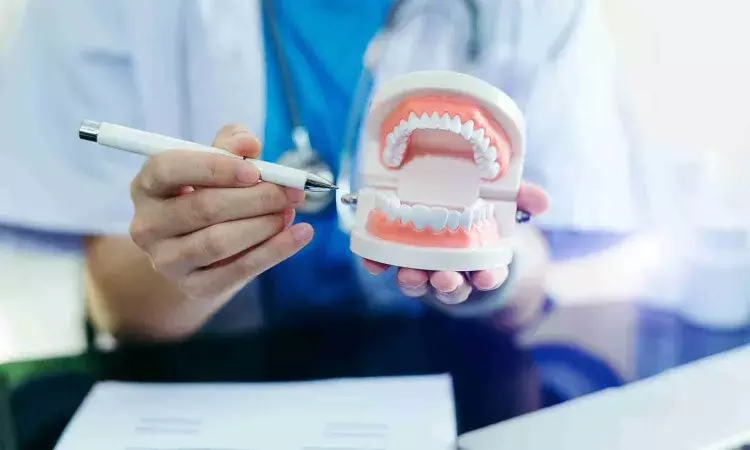- Home
- Medical news & Guidelines
- Anesthesiology
- Cardiology and CTVS
- Critical Care
- Dentistry
- Dermatology
- Diabetes and Endocrinology
- ENT
- Gastroenterology
- Medicine
- Nephrology
- Neurology
- Obstretics-Gynaecology
- Oncology
- Ophthalmology
- Orthopaedics
- Pediatrics-Neonatology
- Psychiatry
- Pulmonology
- Radiology
- Surgery
- Urology
- Laboratory Medicine
- Diet
- Nursing
- Paramedical
- Physiotherapy
- Health news
- Fact Check
- Bone Health Fact Check
- Brain Health Fact Check
- Cancer Related Fact Check
- Child Care Fact Check
- Dental and oral health fact check
- Diabetes and metabolic health fact check
- Diet and Nutrition Fact Check
- Eye and ENT Care Fact Check
- Fitness fact check
- Gut health fact check
- Heart health fact check
- Kidney health fact check
- Medical education fact check
- Men's health fact check
- Respiratory fact check
- Skin and hair care fact check
- Vaccine and Immunization fact check
- Women's health fact check
- AYUSH
- State News
- Andaman and Nicobar Islands
- Andhra Pradesh
- Arunachal Pradesh
- Assam
- Bihar
- Chandigarh
- Chattisgarh
- Dadra and Nagar Haveli
- Daman and Diu
- Delhi
- Goa
- Gujarat
- Haryana
- Himachal Pradesh
- Jammu & Kashmir
- Jharkhand
- Karnataka
- Kerala
- Ladakh
- Lakshadweep
- Madhya Pradesh
- Maharashtra
- Manipur
- Meghalaya
- Mizoram
- Nagaland
- Odisha
- Puducherry
- Punjab
- Rajasthan
- Sikkim
- Tamil Nadu
- Telangana
- Tripura
- Uttar Pradesh
- Uttrakhand
- West Bengal
- Medical Education
- Industry
Enhancing Radiography safety in dentistry- Key uptakes from ADA's updated recommendations

The use of lead abdominal aprons or thyroid collars on patients when conducting dental X-rays is no longer recommended, according to an expert panel established by the American Dental Association (ADA) Council on Scientific Affairs. Additionally, dentists should take into consideration the diagnostic information needed from X-rays to benefit patient care or substantially improve clinical outcomes.
The Journal of the American Dental Association published the new recommendations today, which aim to improve radiation protection in dental radiography and cone-beam computed tomography (CBCT). Medical physicists with the U.S. Food and Drug Administration (FDA) supported the panel’s development of these recommendations – the first on dental imaging safety and radiation protection from the Council since 2012. The Council’s recommendations are also aligned with recent recommendations released by the American Academy of Oral and Maxillofacial Radiology.
After reviewing published studies on radiography, the expert panel determined lead aprons and thyroid collars are not necessary to shield patients from radiation exposure. These recommendations apply to all patients, regardless of age or health status (like pregnancy). Evidence indicates that modern digital X-ray equipment and restricting the beam size only to the area that needs to be imaged better protect patients against radiation exposure to other parts of their body. Lead aprons and thyroid collars can also block the primary X-ray beam, preventing dentists from capturing the image they need.
“When this happens, more radiographs need to be taken, and unnecessary X-rays are what we want to avoid,” said Dr. Purnima Kumar, D.D.S., Ph.D., professor of dentistry and chair of the Department of Periodontology and Oral Medicine at the University of Michigan School of Dentistry and chair of the ADA Council on Scientific Affairs. “The central point of these recommendations is that clinicians should order radiographs in moderation to minimize both patients’ and dental professionals’ exposure to ionizing radiation.”
The recommendations also advise dentists to safeguard patients against unnecessary radiation exposure by:
- Ordering radiographs like X-rays to optimize diagnostic information and enhance patient care outcomes and making every effort to use images acquired at previous dental exams;
- Using digital instead of conventional X-ray film for imaging;
- Restricting the beam size during an X-ray exam to the area that needs to be assessed (an approach called “rectangular collimation”);
- Properly positioning patients so the best image can be taken;
- Incorporating CBCT only when lower-exposure options will not provide the necessary diagnostic information; and
- Adhering to all applicable federal, state and local regulations on radiation safety.
“We encourage dentists and their teams to review these best-practice recommendations, comply with radiation protection regulations and talk with their patients about any questions or concerns before ordering dental imaging,” Dr. Kumar said.
Reference:
Erika Benavides, Joseph R. Krecioch, Roger T. Connolly, Trishul Allareddy, Allison Buchanan, David Spelic, Kelly K. O’Brien, Martha Ann Keels, Ana Karina Mascarenhas, Mai-Ly Duong, Optimizing radiation safety in dentistry: Clinical recommendations and regulatory considerations, The Journal of the American Dental Association, https://doi.org/10.1016/j.adaj.2023.12.002.
Dr Kamal Kant Kohli-MBBS, DTCD- a chest specialist with more than 30 years of practice and a flair for writing clinical articles, Dr Kamal Kant Kohli joined Medical Dialogues as a Chief Editor of Medical News. Besides writing articles, as an editor, he proofreads and verifies all the medical content published on Medical Dialogues including those coming from journals, studies,medical conferences,guidelines etc. Email: drkohli@medicaldialogues.in. Contact no. 011-43720751


